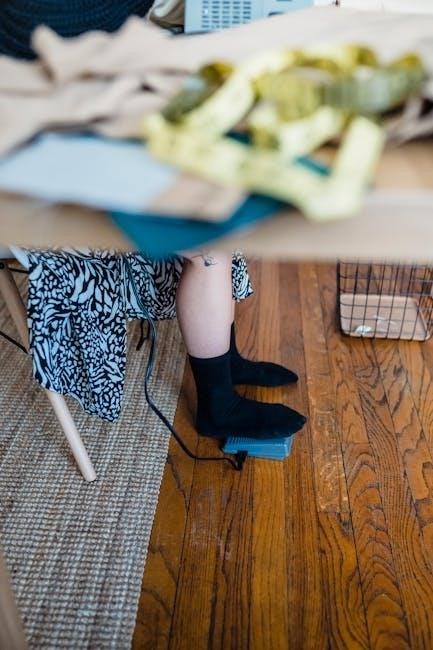
Sewing presser feet are essential attachments that enhance stitching accuracy and efficiency․ They come in various types, each designed for specific fabrics or tasks, ensuring professional results with proper selection and care․
1․1 What Are Sewing Presser Feet?
Sewing presser feet are essential attachments designed to assist with various sewing tasks․ Typically made of metal or plastic, they are interchangeable and designed to hold fabric in place, ensuring even feeding and preventing slippage․ They come in different shapes and sizes, each tailored for specific tasks like zippers, hems, or quilting․ Presser feet help achieve consistent stitching and professional results by guiding fabric accurately under the needle․
1․2 Importance of Presser Feet in Sewing
Presser feet are crucial for enhancing sewing performance, ensuring accuracy, and preventing fabric slippage․ They allow for even feeding and consistent stitching, making them indispensable for achieving professional results․ By using the right foot for specific tasks, sewers can tackle various fabrics and projects with ease, improving efficiency and reducing common sewing issues․
1․3 Brief History of Sewing Presser Feet
Presser feet have evolved significantly since their introduction in the 19th century․ Initially simple metal attachments, they were designed to hold fabric steady during sewing․ Over time, advancements in materials and design led to specialized feet for tasks like zippers and hems․ By the mid-20th century, presser feet became integral to sewing machines, offering precision and versatility․ Today, they remain essential tools for sewists worldwide․
Types of Sewing Presser Feet
Sewing presser feet come in various designs, each tailored for specific tasks, from basic stitching to intricate sewing projects, ensuring precision and versatility for every fabric type;
2․1 Standard or Zigzag Foot
The Standard or Zigzag Foot is a versatile attachment designed for general sewing․ It accommodates both straight and zigzag stitches, making it ideal for everyday projects․ Its wide, flat sole ensures stability on various fabrics, from lightweight cotton to heavier materials․ The foot’s simplicity and adaptability make it a must-have for beginners and experienced sewists alike, ensuring smooth stitching and even fabric feeding․
2․2 Straight Stitch Foot
The Straight Stitch Foot is designed specifically for straight-stitch sewing, offering precision and control․ Its narrow sole prevents fabric from slipping, making it ideal for thin or delicate materials․ Perfect for quilting and precise seam work, this foot ensures consistent stitching and is a go-to for projects requiring straight-line accuracy, such as piecing quilts or sewing fine silks and chiffons․
2․3 Zipper Foot
The Zipper Foot is tailored for sewing zippers, piping, and other narrow trims․ Its unique design allows close proximity to the zipper teeth, ensuring precise alignment and smooth fabric flow․ With a groove on the underside, it guides the zipper without catching, making it essential for bags, clothing, and home decor projects that require professional-looking zipper installations and intricate detailing․
2․4 Walking Foot
The Walking Foot is ideal for handling thick or bulky fabrics like denim and leather․ Its synchronized movement with the machine’s feed dog ensures even fabric flow, preventing bunching or dragging․ This foot is particularly useful for quilting and heavy-duty sewing, providing stability and control over challenging materials, making it a must-have for crafters tackling robust projects that require precision and consistency․
2․5 Rolled Hem Foot
The Rolled Hem Foot is designed for creating neat, narrow hems on lightweight fabrics like silk and chiffon․ It guides the fabric edge to roll under as it sews, producing a professional finish․ Perfect for garments requiring delicate edges, this foot simplifies hemming by eliminating the need for manual folding, ensuring consistent results with minimal effort and maximizing sewing efficiency for beautiful, polished seams․
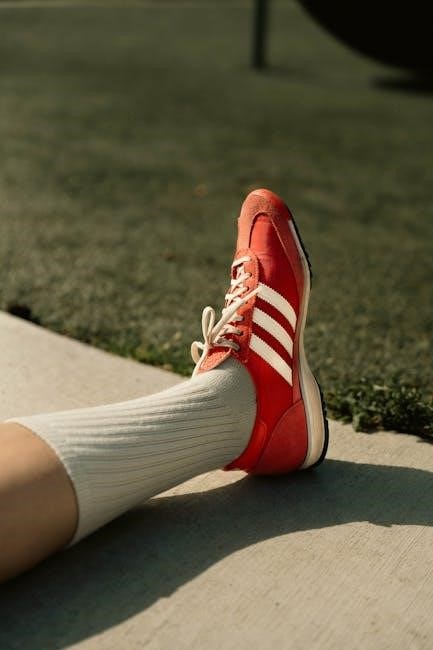
Common Uses and Projects
Presser feet are versatile tools for sewing straight lines, zippers, and heavy fabrics, making them ideal for quilting, hemming, and crafting professional-looking seams with precision and ease․
3․1 Sewing Straight Lines and Basic Stitches
The standard or zigzag foot excels at sewing straight lines and basic stitches, ensuring even fabric feed for consistent results․ It’s ideal for general sewing tasks, providing stability and control, especially on medium-weight fabrics․ This foot is a must-have for beginners, offering reliability for everyday projects like repairing clothes or creating simple home decor items with ease and precision․
3․2 Working with Zippers and Purses
The zipper foot is a must-have for sewing zippers and purses, allowing precise stitching close to the zipper teeth․ Its narrow design ensures fabric stays aligned, preventing bunching or uneven stitching․ This foot is ideal for bag-making, offering control and accuracy․ It simplifies sewing zippers into pouches or purses, ensuring professional-looking results with ease, saving time, and enhancing the overall quality of your handmade accessories․
3․3 Quilting and Heavy Fabric Sewing
Quilting and sewing heavy fabrics require specialized presser feet for smooth operation․ The walking foot excels with thick layers, ensuring even fabric movement and preventing drag․ Its unique design handles denim, canvas, and multiple fabric layers effortlessly․ This foot is a must-have for quilting projects, providing consistent stitching and a professional finish, making it indispensable for sewists tackling bulky or layered materials with precision and ease․
3․4 Hemming and Decorative Stitches
For hemming and decorative stitching, specialized presser feet like the rolled hem foot and decorative stitch foot are invaluable․ The rolled hem foot creates perfect, narrow hems on fabrics like silk or chiffon, while the decorative stitch foot allows for intricate stitching patterns․ These feet ensure clean edges, prevent fabric slippage, and enable precise control over stitching, making them essential for achieving professional-looking hems and embellishments in your sewing projects․
Maintenance and Troubleshooting
Regular cleaning and proper storage of presser feet maintain their functionality․ Adjusting pressure and addressing common issues ensures smooth sewing operations and extends the life of your equipment․
4․1 Cleaning and Storing Presser Feet
Regularly clean presser feet with a soft brush or cloth to remove debris․ Store them in a protective case or pouch to prevent damage․ Avoid exposing them to harsh chemicals or extreme temperatures, as this can alter their shape or finish․ Proper care ensures they remain accurate and functional for various sewing projects and tasks․
4․2 Adjusting Presser Foot Pressure
Proper presser foot pressure ensures even fabric handling and prevents issues like bunching or dragging․ To adjust, use the pressure adjustment screw, typically located on the presser foot mechanism․ Turn the screw clockwise to increase pressure and counterclockwise to decrease it․ Always test the pressure on scrap fabric before sewing to ensure optimal performance․ Refer to your machine’s manual for specific instructions, as adjustments may vary by model․
4․3 Common Issues and Solutions
Common issues with presser feet include improper alignment, uneven pressure, or fabric bunching․ To resolve these, ensure the foot is securely attached and aligned correctly․ Adjust the pressure as needed and clean debris from the foot or machine․ For fabric dragging, try reducing pressure or switching to a specialized foot․ Regular maintenance and correct usage can prevent most issues, ensuring smooth and accurate stitching every time you sew․
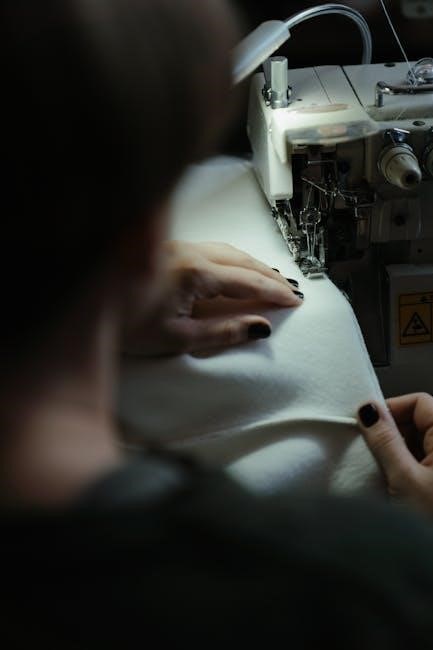
How to Choose the Right Presser Foot
Choosing the right presser foot involves matching it to your fabric type, understanding machine compatibility, and selecting based on the specific sewing task․ Consult your machine’s guide for optimal results and to enhance your sewing experience․
5․1 Understanding Fabric Types and Needs
Choosing the right presser foot starts with understanding your fabric․ Different materials like cotton, silk, leather, or stretch fabrics require specific feet․ For example, a walking foot is ideal for thick or layered fabrics, while a rolled hem foot works best for delicate or flowing materials․ Knowing your fabric’s weight, texture, and flexibility helps in selecting the most suitable presser foot for the task at hand, ensuring smooth stitching and professional results․
5․2 Matching Feet to Specific Sewing Tasks
Matching the right presser foot to your sewing task is crucial for achieving perfect results․ For instance, a zipper foot is ideal for sewing zippers, while a walking foot excels at handling thick or layered fabrics․ A rolled hem foot is perfect for creating delicate hems, and a straight stitch foot ensures precision for basic sewing․ By selecting the right foot for the job, you enhance accuracy, reduce fabric distortion, and achieve professional-looking seams effortlessly․
5;3 Compatibility with Sewing Machines
Ensuring your presser feet are compatible with your sewing machine is vital for optimal performance․ Most feet are designed for specific machine brands or models, so check compatibility before purchasing․ Many modern machines use universal shank systems, while others require adapters․ Always verify the shank type and machine fit to avoid damage or poor stitching results․ Using incompatible feet can lead to improper alignment and compromised stitch quality․
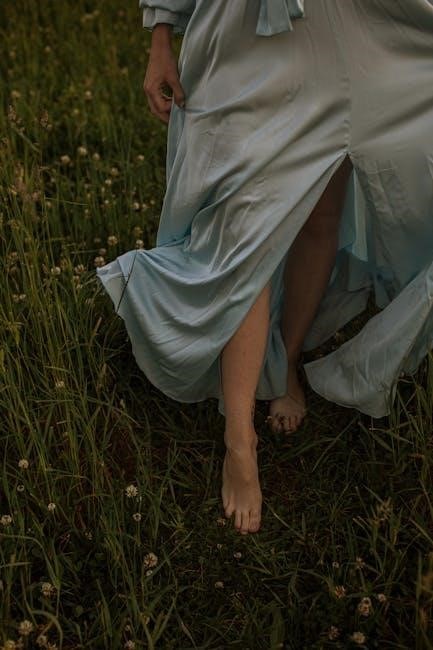
Advanced Techniques and Tips
Master specialized presser feet for professional results, combine feet for unique effects, and optimize machine settings for complex projects, ensuring precision and efficiency in every stitch․
6․1 Using Multiple Feet for Complex Projects
For intricate sewing tasks, combining presser feet can streamline your workflow․ Use a walking foot for heavy fabrics and a zipper foot for precise zipper installation․ This approach enhances accuracy and efficiency, allowing you to tackle complex projects with confidence and achieve professional results․
6․2 Mastering Specialized Feet for Professional Results
Specialized presser feet are key to achieving professional sewing outcomes․ From rolled hem feet for delicate edges to walking feet for heavy fabrics, mastering these tools ensures precise stitching․ Invest time in understanding each foot’s purpose and adjust settings accordingly․ With practice, you’ll unlock their full potential, delivering polished results that elevate your sewing projects to a professional level․
6․3 Combining Feet for Unique Sewing Effects
Combining presser feet creatively can unlock unique sewing effects․ For instance, pairing a walking foot with a roller foot enhances fabric control on thick or slippery materials․ Experimenting with different combinations allows sewists to achieve intricate designs, such as decorative hems or layered stitching․ This technique adds versatility to projects, enabling sewists to explore innovative ways to combine specialized feet for stunning, one-of-a-kind results․
Accessories and Compatibility
Must-have accessories include presser foot adapters and storage cases․ Always check compatibility with your sewing machine to ensure optimal performance and avoid damage to your equipment․
7․1 Must-Have Accessories for Presser Feet
Essential accessories include presser foot storage cases, adapters, and adjustment tools․ These help organize and protect your feet, ensure compatibility, and maintain machine performance․ They are vital for maximizing efficiency and preserving your presser feet investment, allowing you to focus on creating professional-grade sewing projects without hassle or additional costs․
7․2 Checking Compatibility with Your Machine
Compatibility is crucial to ensure proper function․ Use universal adapters for machines without specific foot attachments or check manufacturer guidelines for shank types․ Always visually inspect the presser foot’s shank to match your machine’s requirements, ensuring a secure fit․ This prevents damage and ensures optimal performance․ Adapters can help bridge compatibility gaps, making it easy to use specialized feet across different machines;
7․3 Tips for Upgrading or Customizing Feet
Upgrading or customizing presser feet can enhance sewing performance․ Consider using universal adapters for compatibility across machines․ Always check shank types to ensure proper fit․ For customization, explore DIY modifications or consult professionals․ Experimenting with unique combinations can unlock creative possibilities․ Prioritize quality materials to maintain durability and functionality․ Regularly inspect and maintain customized feet to ensure optimal results and prevent damage to your machine or fabrics․
Safety and Best Practices
Always keep hands clear of moving parts and ensure the presser foot is securely attached․ Maintain a stable workspace and avoid distractions while sewing for safety․
8․1 Safety Precautions When Using Presser Feet
Always keep hands and loose clothing away from moving parts․ Ensure the presser foot is securely attached to prevent accidents․ Avoid distractions while sewing and never touch sharp objects near the machine․ Turn off the machine when changing feet or handling fabrics․ Store presser feet safely when not in use to avoid injuries․ Keep children away from the sewing machine and use protective gear if needed․
8․2 Proper Handling and Care of Feet
Handle presser feet gently to avoid damage or bending․ Clean them regularly with a soft cloth to remove debris․ Store each foot separately in a protective case to prevent scratching․ Ensure compatibility with your machine before use․ Avoid using force when attaching or detaching feet․ Regularly inspect for wear and tear․ Proper care extends their lifespan and ensures optimal performance in various sewing projects․
8․3 Avoiding Common Mistakes
Avoid using incorrect presser feet for specific tasks, as this can damage fabric or the machine․ Never force a foot onto the machine, as it may bend or break․ Ensure the foot is securely attached before sewing․ Keep fingers clear of moving parts and avoid sewing over pins․ Regularly check for proper alignment and pressure settings․ Proper techniques prevent errors and ensure safe, efficient sewing experiences for all skill levels․
Real-World Examples and Applications
Presser feet are crucial for sewing leather goods, stretch fabrics, and creating professional seams․ They enhance precision and versatility in various sewing projects, from quilting to everyday repairs․
9․1 Sewing Leather Goods with the Right Foot
When sewing leather goods, using the correct presser foot is vital for smooth stitching and preventing fabric sticking․ A Teflon or leather-specific foot is ideal, as it glides effortlessly over thick materials․ Proper foot selection ensures even tension, preventing skipped stitches and providing durable, professional-looking seams․ This is especially important for items like belts or handbags, where precision and neatness are key to a polished finish․
9․2 Using Presser Feet for Stretch Fabrics
For sewing stretch fabrics like knits, a Teflon or stretch-specific presser foot is ideal․ These feet prevent fabric stretching and distortion, ensuring smooth stitching․ They maintain even tension, minimizing skipped stitches and puckering․ This foot is perfect for garments requiring flexibility, such as activewear or leggings, providing professional-looking results with ease and precision․
9․3 Creating Professional-Looking Seams
Achieving professional seams requires the right presser foot for the job․ The straight stitch foot ensures precise, straight lines, while the zigzag foot handles curves and stretch fabrics effortlessly․ Using specialized feet like the overlock or blind hem foot can add finishes that mimic professional tailoring, giving your projects a polished look with minimal effort and expertise․
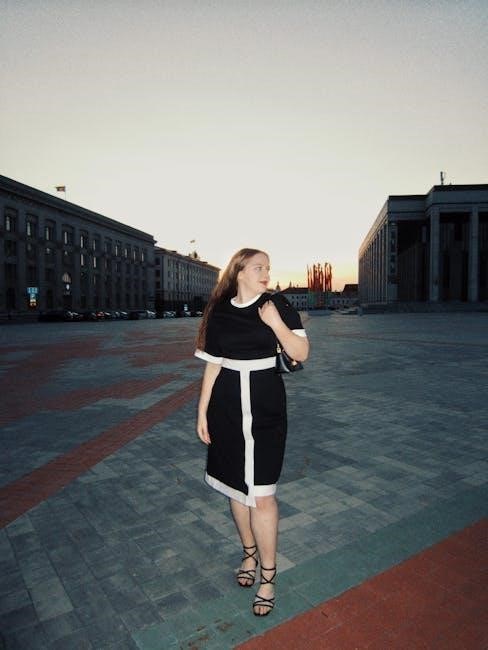
Expert Tips and Tricks
Sewing presser feet unlock your machine’s potential․ Experiment with different feet for versatility, keep them clean, and master techniques like combining feet for unique effects and professional results․
10․1 Maximizing Efficiency with the Right Foot
Choosing the right presser foot can significantly boost your sewing efficiency․ For instance, the walking foot excels with thick fabrics, while the rolled hem foot simplifies edge finishing․ Experimenting with specialized feet ensures optimal results, saving time and reducing fabric waste․ Always test feet on scrap fabric to gauge performance and adjust settings as needed for precise stitching and professional outcomes․
10․2 Mastering Presser Foot Techniques
Mastering presser foot techniques involves understanding their unique functions and practicing their use․ Start with basic feet like the zigzag foot for straight lines and gradually explore specialized ones․ Adjusting presser foot pressure ensures smooth fabric flow․ Regular practice helps refine skills, especially for intricate tasks like zippers or quilting․ Patience and experimentation are key to achieving professional results and expanding your sewing capabilities effectively․
10․3 Saving Time with Proper Foot Selection
Proper presser foot selection streamlines sewing projects, saving time and effort․ Matching the right foot to the task ensures smooth fabric handling and precise stitching․ For example, using a zipper foot for zippers or a walking foot for heavy fabrics minimizes adjustments and reduces errors․ This approach allows sewists to complete projects efficiently, focusing on creativity rather than technical challenges, and achieving professional-quality results consistently․
Leave a Reply
You must be logged in to post a comment.